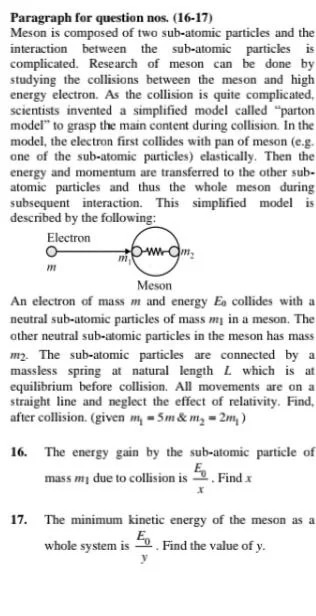Question
Question: Paragraph for question nos. (16-17) Meson is composed of two sub-atomic particles and the interacti...
Paragraph for question nos. (16-17) Meson is composed of two sub-atomic particles and the interaction between the sub-atomic particles is complicated. Research of meson can be done by studying the collisions between the meson and high energy electron. As the collision is quite complicated, scientists invented a simplified model called "parton model" to grasp the main content during collision. In the model, the electron first collides with pan of meson (e.g. one of the sub-atomic particles) elastically. Then the energy and momentum are transferred to the other sub-atomic particles and thus the whole meson during subsequent interaction. This simplified model is described by the following: [figure] An electron of mass m and energy E0 collides with a neutral sub-atomic particles of mass m1 in a meson. The other neutral sub-atomic particles in the meson has mass m2. The sub-atomic particles are connected by a massless spring at natural length L which is at equilibrium before collision. All movements are on a straight line and neglect the effect of relativity. Find, after collision. (given m1=5m & m2=2m1)
-
The energy gain by the sub-atomic particle of mass m1 due to collision is xE0. Find x
-
The minimum kinetic energy of the meson as a whole system is yE0. Find the value of y.

x = 9/5
x = 5/9
y = 27/5
y = 5/27
- x=59, 17. y=527
Solution
Question 16: The collision is elastic between the electron (mass m, initial velocity ve) and particle m1 (mass m1, initially at rest). Initial energy of electron: E0=21mve2. Final velocity of m1 after elastic collision: v1′=m+m12mve. Given m1=5m, so v1′=m+5m2mve=6m2mve=31ve. Energy gain by m1: ΔKE1=21m1(v1′)2=21(5m)(31ve)2=95(21mve2)=95E0. Given ΔKE1=xE0, so 95E0=xE0⟹x=59.
Question 17: The kinetic energy of the meson's center of mass (KECM). KECM=21(m1+m2)VCM2. Momentum of meson system after collision: Pmeson=m1v1′. VCM=m1+m2Pmeson=m1+m2m1v1′. KECM=2(m1+m2)(m1v1′)2. Given m1=5m and m2=2m1=10m, so m1+m2=15m. v1′=31ve, and ve2=m2E0. KECM=2(15m)(5m)2(31ve)2=30m25m2⋅91m2E0=30m25m⋅92E0=27050E0=275E0. Since VCM is constant, KECM is the minimum kinetic energy. Given KECM=yE0, so 275E0=yE0⟹y=527.
